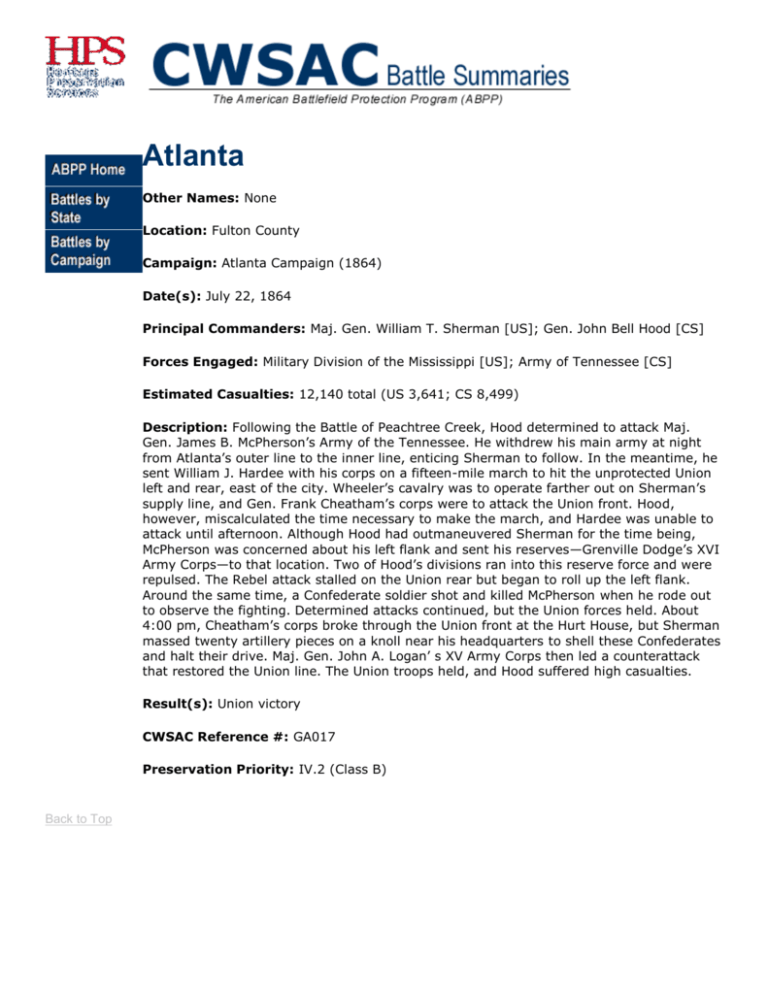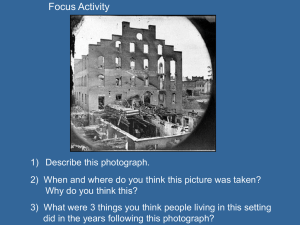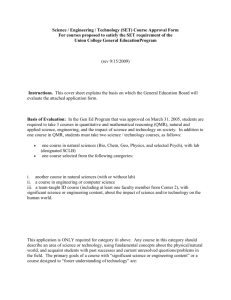Battle summaries - Lake County Schools
advertisement

Atlanta Other Names: None Location: Fulton County Campaign: Atlanta Campaign (1864) Date(s): July 22, 1864 Principal Commanders: Maj. Gen. William T. Sherman [US]; Gen. John Bell Hood [CS] Forces Engaged: Military Division of the Mississippi [US]; Army of Tennessee [CS] Estimated Casualties: 12,140 total (US 3,641; CS 8,499) Description: Following the Battle of Peachtree Creek, Hood determined to attack Maj. Gen. James B. McPherson’s Army of the Tennessee. He withdrew his main army at night from Atlanta’s outer line to the inner line, enticing Sherman to follow. In the meantime, he sent William J. Hardee with his corps on a fifteen-mile march to hit the unprotected Union left and rear, east of the city. Wheeler’s cavalry was to operate farther out on Sherman’s supply line, and Gen. Frank Cheatham’s corps were to attack the Union front. Hood, however, miscalculated the time necessary to make the march, and Hardee was unable to attack until afternoon. Although Hood had outmaneuvered Sherman for the time being, McPherson was concerned about his left flank and sent his reserves—Grenville Dodge’s XVI Army Corps—to that location. Two of Hood’s divisions ran into this reserve force and were repulsed. The Rebel attack stalled on the Union rear but began to roll up the left flank. Around the same time, a Confederate soldier shot and killed McPherson when he rode out to observe the fighting. Determined attacks continued, but the Union forces held. About 4:00 pm, Cheatham’s corps broke through the Union front at the Hurt House, but Sherman massed twenty artillery pieces on a knoll near his headquarters to shell these Confederates and halt their drive. Maj. Gen. John A. Logan’ s XV Army Corps then led a counterattack that restored the Union line. The Union troops held, and Hood suffered high casualties. Result(s): Union victory CWSAC Reference #: GA017 Preservation Priority: IV.2 (Class B) Back to Top Chickamauga Other Names: None Location: Catoosa County and Walker County Campaign: Chickamauga Campaign (1863) Date(s): September 18-20, 1863 Principal Commanders: Maj. Gen. William S. Rosecrans and Maj. Gen. George H. Thomas [US]; Gen. Braxton Bragg and Lt. Gen. James Longstreet [CS] Forces Engaged: The Army of the Cumberland [US]; Army of Tennessee [CS] Estimated Casualties: 34,624 total (US 16,170; CS 18,454) Description: After the Tullahoma Campaign, Rosecrans renewed his offensive, aiming to force the Confederates out of Chattanooga. The three army corps comprising Rosecrans’ s army split and set out for Chattanooga by separate routes. In early September, Rosecrans consolidated his forces scattered in Tennessee and Georgia and forced Bragg’s army out of Chattanooga, heading south. The Union troops followed it and brushed with it at Davis’ Cross Roads. Bragg was determined to reoccupy Chattanooga and decided to meet a part of Rosecrans’s army, defeat them, and then move back into the city. On the 17th he headed north, intending to meet and beat the XXI Army Corps. As Bragg marched north on the 18th, his cavalry and infantry fought with Union cavalry and mounted infantry which were armed with Spencer repeating rifles. Fighting began in earnest on the morning of the 19th, and Bragg’s men hammered but did not break the Union line. The next day, Bragg continued his assault on the Union line on the left, and in late morning, Rosecrans was informed that he had a gap in his line. In moving units to shore up the supposed gap, Rosencrans created one, and James Longstreet’s men promptly exploited it, driving onethird of the Union army, including Rosecrans himself, from the field. George H. Thomas took over command and began consolidating forces on Horseshoe Ridge and Snodgrass Hill. Although the Rebels launched determined assaults on these forces, they held until after dark. Thomas then led these men from the field leaving it to the Confederates. The Union retired to Chattanooga while the Rebels occupied the surrounding heights. Result(s): Confederate victory National Park Unit: Chickamauga and Chattanooga NMP New Orleans Other Names: None Location: Orleans Parish and St. Bernard Parish Campaign: Expedition to and Capture of New Orleans (1862) Date(s): April 25–May 1, 1862 Principal Commanders: Flag-Officer David G. Farragut and Maj. Gen. Benjamin Franklin Butler [US]; Maj. Gen. Mansfield Lovell [CS] Forces Engaged: Department of the Gulf [US]; Department No. 1 [CS] Estimated Casualties: None Description: Following the passage of forts Jackson and St. Philip, near the mouth of the Mississippi River, on April 24, 1862, the Union occupation of New Orleans was inevitable. Union Flag-Officer David G. Farragut, with his squadron, continued up the Mississippi River and demanded the surrender of the City of New Orleans the next day. The city surrendered on April 28. On May 1, Maj. Gen. Benjamin Franklin Butler’s army began landing at New Orleans and occupying the city. New Orleans, considered an international city and the largest city in the Confederacy, had fallen. The Union occupation of New Orleans was an event that had major international significance. Result(s): Union victory Antietam Other Names: Sharpsburg Location: Washington County Campaign: Maryland Campaign (September 1862) Date(s): September 16-18, 1862 Principal Commanders: Maj. Gen. George B. McClellan [US]; Gen. Robert E. Lee [CS] Forces Engaged: Armies Estimated Casualties: 23,100 total Description: On September 16, Maj. Gen. George B. McClellan confronted Lee’s Army of Northern Virginia at Sharpsburg, Maryland. At dawn September 17, Hooker’s corps mounted a powerful assault on Lee’s left flank that began the single bloodiest day in American military history. Attacks and counterattacks swept across Miller’s cornfield and fighting swirled around the Dunker Church. Union assaults against the Sunken Road eventually pierced the Confederate center, but the Federal advantage was not followed up. Late in the day, Burnside’s corps finally got into action, crossing the stone bridge over Antietam Creek and rolling up the Confederate right. At a crucial moment, A.P. Hill’s division arrived from Harpers Ferry and counterattacked, driving back Burnside and saving the day. Although outnumbered two-to-one, Lee committed his entire force, while McClellan sent in less than three-quarters of his army, enabling Lee to fight the Federals to a standstill. During the night, both armies consolidated their lines. In spite of crippling casualties, Lee continued to skirmish with McClellan throughout the 18th, while removing his wounded south of the river. McClellan did not renew the assaults. After dark, Lee ordered the battered Army of Northern Virginia to withdraw across the Potomac into the Shenandoah Valley. Result(s): Inconclusive (Union strategic victory.) Vicksburg Other Names: None Location: Warren County Campaign: Grant’s Operations against Vicksburg (1863) Date(s): May 18-July 4, 1863 Principal Commanders: Maj. Gen. Ulysses S. Grant [US]; Lt. Gen. John C. Pemberton [CS] Forces Engaged: Army of the Tennessee [US]; Army of Vicksburg [CS] Estimated Casualties: 19,233 total (US 10,142; CS 9,091) Description: In May and June of 1863, Maj. Gen. Ulysses S. Grant’s armies converged on Vicksburg, investing the city and entrapping a Confederate army under Lt. Gen. John Pemberton. On July 4, Vicksburg surrendered after prolonged siege operations. This was the culmination of one of the most brilliant military campaigns of the war. With the loss of Pemberton’s army and this vital stronghold on the Mississippi, the Confederacy was effectively split in half. Grant's successes in the West boosted his reputation, leading ultimately to his appointment as General-in-Chief of the Union armies. Result(s): Union victory Fort Sumter Other Names: None Location: Charleston County Campaign: Operations in Charleston Harbor (April 1861) Date(s): April 12-14, 1861 Principal Commanders: Maj. Robert Anderson [US]; Brig. Gen. P.G.T. Beauregard [CS] Forces Engaged: Regiments: 580 total (US 80; CS est. 500) Estimated Casualties: None Description: On April 10, 1861, Brig. Gen. Beauregard, in command of the provisional Confederate forces at Charleston, South Carolina, demanded the surrender of the Union garrison of Fort Sumter in Charleston Harbor. Garrison commander Anderson refused. On April 12, Confederate batteries opened fire on the fort, which was unable to reply effectively. At 2:30 pm, April 13, Major Anderson surrendered Fort Sumter, evacuating the garrison on the following day. The bombardment of Fort Sumter was the opening engagement of the American Civil War. Although there were no casualties during the bombardment, one Union artillerist was killed and three wounded (one mortally) when a cannon exploded prematurely while firing a salute during the evacuation on April 14. Result(s): Confederate victory Shiloh Campaign: Federal Penetration up the Cumberland and Tennessee Rivers (1862) Date(s): April 6-7, 1862 Principal Commanders: Maj. Gen. Ulysses S. Grant and Maj. Gen. Don Carlos Buell [US]; Gen. Albert Sidney Johnston and Gen. P.G.T. Beauregard [CS] Forces Engaged: Army of the Tennessee and Army of the Ohio (65,085) [US]; Army of the Mississippi (44,968) [CS] Estimated Casualties: 23,746 total (US 13,047; CS 10,699) Description: As a result of the fall of Forts Henry and Donelson, Confederate Gen. Albert Sidney Johnston, the commander in the area, was forced to fall back, giving up Kentucky and much of West and Middle Tennessee. He chose Corinth, Mississippi, a major transportation center, as the staging area for an offensive against Maj. Gen. Ulysses S. Grant and his Army of the Tennessee before the Army of the Ohio, under Maj. Gen. Don Carlos Buell, could join it. The Confederate retrenchment was a surprise, although a pleasant one, to the Union forces, and it took Grant, with about 40,000 men, some time to mount a southern offensive, along the Tennessee River, toward Pittsburg Landing. Grant received orders to await Buell’s Army of the Ohio at Pittsburg Landing. Grant did not choose to fortify his position; rather, he set about drilling his men many of which were raw recruits. Johnston originally planned to attack Grant on April 4, but delays postponed it until the 6th. Attacking the Union troops on the morning of the 6th, the Confederates surprised them, routing many. Some Federals made determined stands and by afternoon, they had established a battle line at the sunken road, known as the “Hornets Nest.” Repeated Rebel attacks failed to carry the Hornets Nest, but massed artillery helped to turn the tide as Confederates surrounded the Union troops and captured, killed, or wounded most. Johnston had been mortally wounded earlier and his second in command, Gen. P.G.T. Beauregard, took over. The Union troops established another line covering Pittsburg Landing, anchored with artillery and augmented by Buell’s men who began to arrive and take up positions. Fighting continued until after dark, but the Federals held. By the next morning, the combined Federal forces numbered about 40,000, outnumbering Beauregard’s army of less than 30,000. Beauregard was unaware of the arrival of Buell’s army and launched a counterattack in response to a two-mile advance by William Nelson’s division of Buell’s army at 6:00 am, which was, at first, successful. Union troops stiffened and began forcing the Confederates back. Beauregard ordered a counterattack, which stopped the Union advance but did not break its battle line. At this point, Beauregard realized that he could not win and, having suffered too many casualties, he retired from the field and headed back to Corinth. On the 8th, Grant sent Brig. Gen. William T. Sherman, with two brigades, and Brig. Gen. Thomas J. Wood, with his division, in pursuit of Beauregard. They ran into the Rebel rearguard, commanded by Col. Nathan Bedford Forrest, at Fallen Timbers. Forrest’s aggressive tactics, although eventually contained, influenced the Union troops to return to Pittsburg Landing. Grant’s mastery of the Confederate forces continued; he had beaten them once again. The Confederates continued to fall back until launching their mid-August offensive. Result(s): Union victory Appomattox Court House Other Names: None Location: Appomattox County Campaign: Appomattox Campaign (March-April 1865) Date(s): April 9, 1865 Principal Commanders: Lt. Gen. Ulysses S. Grant [US]; Gen. Robert E. Lee [CS] Forces Engaged: Armies Estimated Casualties: 700 total (27,805 Confederate soldiers paroled) Description:Early on April 9, the remnants of John Broun Gordon’s corps and Fitzhugh Lee’s cavalry formed line of battle at Appomattox Court House. Gen. Robert E. Lee determined to make one last attempt to escape the closing Union pincers and reach his supplies at Lynchburg. At dawn the Confederates advanced, initially gaining ground against Sheridan’s cavalry. The arrival of Union infantry, however, stopped the advance in its tracks. Lee’s army was now surrounded on three sides. Lee surrendered to Grant on April 9. This was the final engagement of the war in Virginia. Result(s): Union victory Cold Harbor Other Names: Second Cold Harbor Location: Hanover County Campaign: Grant’s Overland Campaign (May-June 1864) Date(s): May 31-June 12, 1864 Principal Commanders: Lt. Gen. Ulysses S. Grant and Maj. Gen. George G. Meade [US]; Gen. Robert E. Lee [CS] Forces Engaged: 170,000 total (US 108,000; CS 62,000) Estimated Casualties: 15,500 total (US 13,000; CS 2,500) Description: On May 31, Sheridan’s cavalry seized the vital crossroads of Old Cold Harbor. Early on June 1, relying heavily on their new repeating carbines and shallow entrenchments, Sheridan’s troopers threw back an attack by Confederate infantry. Confederate reinforcements arrived from Richmond and from the Totopotomoy Creek lines. Late on June 1, the Union VI and XVIII Corps reached Cold Harbor and assaulted the Confederate works with some success. By June 2, both armies were on the field, forming on a seven-mile front that extended from Bethesda Church to the Chickahominy River. At dawn June 3, the II and XVIII Corps, followed later by the IX Corps, assaulted along the Bethesda Church-Cold Harbor line and were slaughtered at all points. Grant commented in his memoirs that this was the only attack he wished he had never ordered. The armies confronted each other on these lines until the night of June 12, when Grant again advanced by his left flank, marching to James River. On June 14, the II Corps was ferried across the river at Wilcox’s Landing by transports. On June 15, the rest of the army began crossing on a 2,200-foot long pontoon bridge at Weyanoke. Abandoning the welldefended approaches to Richmond, Grant sought to shift his army quickly south of the river to threaten Petersburg. Result(s): Confederate victory Fredericksburg I Other Names: Marye’s Heights Location: Spotsylvania County and Fredericksburg Campaign: Fredericksburg Campaign (November-December 1862) Date(s): December 11-15, 1862 Principal Commanders: Maj. Gen. Ambrose E. Burnside [US]; Gen. Robert E. Lee [CS] Forces Engaged: 172,504 total (US 100,007; CS 72,497) Estimated Casualties: 17,929 total (US 13,353; CS 4,576) Description: On November 14, Burnside, now in command of the Army of the Potomac, sent a corps to occupy the vicinity of Falmouth near Fredericksburg. The rest of the army soon followed. Lee reacted by entrenching his army on the heights behind the town. On December 11, Union engineers laid five pontoon bridges across the Rappahannock under fire. On the 12th, the Federal army crossed over, and on December 13, Burnside mounted a series of futile frontal assaults on Prospect Hill and Marye’s Heights that resulted in staggering casualties. Meade’s division, on the Union left flank, briefly penetrated Jackson’s line but was driven back by a counterattack. Union generals C. Feger Jackson and George Bayard, and Confederate generals Thomas R.R. Cobb and Maxey Gregg were killed. On December 15, Burnside called off the offensive and recrossed the river, ending the campaign. Burnside initiated a new offensive in January 1863, which quickly bogged down in the winter mud. The abortive “Mud March” and other failures led to Burnside’s replacement by Maj. Gen. Joseph Hooker in January 1863. Result(s): Confederate victory Manassas, First Other Names: First Bull Run Location: Fairfax County and Prince William County Campaign: Manassas Campaign (July 1861) Date(s): July 21, 1861 Principal Commanders: Brig. Gen. Irvin McDowell [US]; Brig. Gen. Joseph E. Johnston and Brig. Gen. P.G.T. Beauregard [CS] Forces Engaged: 60,680 total (US 28,450; CS 32,230) Estimated Casualties: 4,700 total (US 2,950; CS 1,750) Description: This was the first major land battle of the armies in Virginia. On July 16, 1861, the untried Union army under Brig. Gen. Irvin McDowell marched from Washington against the Confederate army, which was drawn up behind Bull Run beyond Centreville. On the 21st, McDowell crossed at Sudley Ford and attacked the Confederate left flank on Matthews Hill. Fighting raged throughout the day as Confederate forces were driven back to Henry Hill. Late in the afternoon, Confederate reinforcements (one brigade arriving by rail from the Shenandoah Valley) extended and broke the Union right flank. The Federal retreat rapidly deteriorated into a rout. Although victorious, Confederate forces were too disorganized to pursue. Confederate Gen. Bee and Col. Bartow were killed. Thomas J. Jackson earned the nom de guerre “Stonewall.” By July 22, the shattered Union army reached the safety of Washington. This battle convinced the Lincoln administration that the war would be a long and costly affair. McDowell was relieved of command of the Union army and replaced by Maj. Gen. George B. McClellan, who set about reorganizing and training the troops. Result(s): Confederate victory Manassas, Second Other Names: Manassas, Second Bull Run, Manassas Plains, Groveton, Gainesville, Brawner's Farm Location: Prince William County Campaign: Northern Virginia Campaign (June-September 1862) Date(s): August 28-30, 1862 Principal Commanders: Maj. Gen. John Pope [US]; Gen. Robert E. Lee and Maj. Gen. Thomas J. Jackson [CS] Forces Engaged: Armies Estimated Casualties: 22,180 total (US 13,830; CS 8,350) Description: In order to draw Pope’s army into battle, Jackson ordered an attack on a Federal column that was passing across his front on the Warrenton Turnpike on August 28. The fighting at Brawner Farm lasted several hours and resulted in a stalemate. Pope became convinced that he had trapped Jackson and concentrated the bulk of his army against him. On August 29, Pope launched a series of assaults against Jackson’s position along an unfinished railroad grade. The attacks were repulsed with heavy casualties on both sides. At noon, Longstreet arrived on the field from Thoroughfare Gap and took position on Jackson’s right flank. On August 30, Pope renewed his attacks, seemingly unaware that Longstreet was on the field. When massed Confederate artillery devastated a Union assault by Fitz John Porter’s command, Longstreet’s wing of 28,000 men counterattacked in the largest, simultaneous mass assault of the war. The Union left flank was crushed and the army driven back to Bull Run. Only an effective Union rearguard action prevented a replay of the First Manassas disaster. Pope’s retreat to Centreville was precipitous, nonetheless. The next day, Lee ordered his army in pursuit. This was the decisive battle of the Northern Virginia Campaign. Result(s): Confederate victory Olustee Other Names: Ocean Pond Location: Baker County Campaign: Florida Expedition (1864) Date(s): February 20, 1864 Principal Commanders: Brig. Gen. Truman Seymour [US]; Brig. Gen. Joseph Finegan [CS] Forces Engaged: Division [US]; District of East Florida [CS] Estimated Casualties: 2,806 total (US 1,860; CS 946) Description: In February 1864, the commander of the Department of the South, Maj. Gen. Quincy A. Gillmore, launched an expedition into Florida to secure Union enclaves, sever Rebel supply routes, and recruit black soldiers. Brig. Gen. Truman Seymour moved deep into the state, occupying, destroying, and liberating, meeting little resistance on February 20, he approached Brig. Gen. Joseph Finegan’s 5,000 Confederates entrenched near Olustee. One infantry brigade pushed out to meet Seymour’s advance units. The Union forces attacked but were repulsed. The battle raged, and as Finegan committed the last of his reserves, the Union line broke and began to retreat. Finegan did not exploit the retreat, allowing most of the fleeing Union forces to reach Jacksonville. Result(s): Confederate victory Chattanooga Other Names: None Location: Hamilton County and City of Chattanooga Campaign: Chattanooga-Ringgold Campaign (1863) Date(s): November 23-25, 1863 Principal Commanders: Maj. Gen. Ulysses S. Grant [US]; Gen. Braxton Bragg [CS] Forces Engaged: Military Division of the Mississippi [US]; Army of Tennessee [CS] Estimated Casualties: 12,485 total (US 5,815; CS 6,670) Description: From the last days of September through October 1863, Gen. Braxton Bragg’s army laid siege to the Union army under Maj. Gen. William Rosecrans at Chattanooga, cutting off its supplies. On October 17, Maj. Gen. Ulysses S. Grant received command of the Western armies; he moved to reinforce Chattanooga and replaced Rosecrans with Maj. Gen. George Thomas. A new supply line was soon established. Maj. Gen. William T. Sherman arrived with his four divisions in mid-November, and the Federals began offensive operations. On November 23-24, Union forces struck out and captured Orchard Knob and Lookout Mountain. On November 25, Union soldiers assaulted and carried the seemingly impregnable Confederate position on Missionary Ridge. One of the Confederacy’s two major armies was routed. The Federals held Chattanooga, the “Gateway to the Lower South,” which became the supply and logistics base for Sherman’s 1864 Atlanta Campaign. Result(s): Union victory Stones River Other Names: Murfreesboro Location: Rutherford County Campaign: Stones River Campaign (1862-63) Date(s): December 31, 1862-January 2, 1863 Principal Commanders: Maj. Gen. William S. Rosecrans [US]; Gen. Braxton Bragg [CS] Forces Engaged: Army of the Cumberland [US]; Army of Tennessee [CS] Estimated Casualties: 23,515 total (US 13,249; CS 10,266) Description: After Gen. Braxton Bragg’s defeat at Perryville, Kentucky, October 8, 1862, he and his Confederate Army of the Mississippi retreated, reorganized, and were redesignated as the Army of Tennessee. They then advanced to Murfreesboro, Tennessee, and prepared to go into winter quarters. Maj. Gen. William S. Rosecrans’s Union Army of the Cumberland followed Bragg from Kentucky to Nashville. Rosecrans left Nashville on December 26, with about 44,000 men, to defeat Bragg’s army of more than 37,000. He found Bragg’s army on December 29 and went into camp that night, within hearing distance of the Rebels. At dawn on the 31st, Bragg’s men attacked the Union right flank. The Confederates had driven the Union line back to the Nashville Pike by 10:00 am but there it held. Union reinforcements arrived from Rosecrans’s left in the late forenoon to bolster the stand, and before fighting stopped that day the Federals had established a new, strong line. On New Years Day, both armies marked time. Bragg surmised that Rosecrans would now withdraw, but the next morning he was still in position. In late afternoon, Bragg hurled a division at a Union division that, on January 1, had crossed Stones River and had taken up a strong position on the bluff east of the river. The Confederates drove most of the Federals back across McFadden’s Ford, but with the assistance of artillery, the Federals repulsed the attack, compelling the Rebels to retire to their original position. Bragg left the field on the January 4-5, retreating to Shelbyville and Tullahoma, Tennessee. Rosecrans did not pursue, but as the Confederates retired, he claimed the victory. Stones River boosted Union morale. The Confederates had been thrown back in the east, west, and in the Trans-Mississippi. Result(s): Union victory Chancellorsville Other Names: None Location: Spotsylvania County Campaign: Chancellorsville Campaign (April-May 1863) Date(s): April 30-May 6, 1863 Principal Commanders: Maj. Gen. Joseph Hooker [US]; Gen. Robert E. Lee and Maj. Gen. Thomas J. Jackson [CS] Forces Engaged: 154,734 total (US 97,382; CS 57,352) Estimated Casualties: 24,000 total (US 14,000; CS 10,000) Description: On April 27, Maj. Gen. Joseph Hooker led the V, XI, and XII Corps on a campaign to turn the Confederate left flank by crossing the Rappahannock and Rapidan Rivers above Fredericksburg. Passing the Rapidan via Germanna and Ely’s Fords, the Federals concentrated near Chancellorsville on April 30 and May 1. The III Corps was ordered to join the army via United States Ford. Sedgwick’s VI Corps and Gibbon’s division remained to demonstrate against the Confederates at Fredericksburg. In the meantime, Lee left a covering force under Maj. Gen. Jubal Early in Fredericksburg and marched with the rest of the army to confront the Federals. As Hooker’s army moved toward Fredericksburg on the Orange Turnpike, they encountered increasing Confederate resistance. Hearing reports of overwhelming Confederate force, Hooker ordered his army to suspend the advance and to concentrate again at Chancellorsville. Pressed closely by Lee’s advance, Hooker adopted a defensive posture, thus giving Lee the initiative. On the morning of May 2, Lt. Gen. T.J. Jackson directed his corps on a march against the Federal left flank, which was reported to be “hanging in the air.” Fighting was sporadic on other portions of the field throughout the day, as Jackson’s column reached its jump-off point. At 5:20 pm, Jackson’s line surged forward in an overwhelming attack that crushed the Union XI Corps. Federal troops rallied, resisted the advance, and counterattacked. Disorganization on both sides and darkness ended the fighting. While making a night reconnaissance, Jackson was mortally wounded by his own men and carried from the field. J.E.B. Stuart took temporary command of Jackson’s Corps. On May 3, the Confederates attacked with both wings of the army and massed their artillery at Hazel Grove. This finally broke the Federal line at Chancellorsville. Hooker withdrew a mile and entrenched in a defensive “U” with his back to the river at United States Ford. Union generals Berry and Whipple and Confederate general Paxton were killed; Stonewall Jackson was mortally wounded. On the night of May 5-6, after Union reverses at Salem Church, Hooker recrossed to the north bank of the Rappahannock. This battle was considered by many historians to be Lee’s greatest victory. Result(s): Confederate victory Petersburg Other Names: Petersburg Location: City of Petersburg Campaign: Appomattox Campaign (March-April 1865) Date(s): April 2, 1865 Principal Commanders: Lt. Gen. Ulysses S. Grant [US]; Gen. Robert E. Lee [CS] Forces Engaged: Armies Estimated Casualties: 7,750 total (US 3,500; CS 4,250) Description: With Confederate defeat at Five Forks on April 1, Grant and Meade ordered a general assault against the Petersburg lines by II, IX, VI and XXIV Corps on April 2. A heroic defense of Fort Gregg by a handful of Confederates prevented the Federals from entering the city that night. Lt. Gen. A.P. Hill was killed trying to reach his troops in the confusion. After dark, Lee ordered the evacuation of Petersburg and Richmond. Grant had achieved one of the major military objectives of the war: the capture of Petersburg, which led to the fall of Richmond, the Capitol of the Confederacy. Result(s): Union victory Wilderness Other Names: Combats at Parker’s Store, Craig’s Meeting House, Todd’s Tavern, Brock Road, the Furnaces Location: Spotsylvania and Orange Counties Campaign: Grant’s Overland Campaign (May-June 1864) Date(s): May 5-7, 1864 Principal Commanders: Lt. Gen. Ulysses S. Grant and Maj. Gen. George G. Meade [US]; Gen. Robert E. Lee [CS] Forces Engaged: 162,920 total (US 101,895; CS 61,025) Estimated Casualties: 29,800 total (US 18,400; CS 11,400) Description: The opening battle of Grant’s sustained offensive against the Confederate Army of Northern Virginia, known as the Overland Campaign, was fought at the Wilderness, May 5-7. On the morning of May 5, 1864, the Union V Corps attacked Ewell’s Corps on the Orange Turnpike, while A.P. Hill’s corps during the afternoon encountered Getty’s Division (VI Corps) and Hancock’s II Corps on the Plank Road. Fighting was fierce but inconclusive as both sides attempted to maneuver in the dense woods. Darkness halted the fighting, and both sides rushed forward reinforcements. At dawn on May 6, Hancock attacked along the Plank Road, driving Hill’s Corps back in confusion. Longstreet’s Corps arrived in time to prevent the collapse of the Confederate right flank. At noon, a devastating Confederate flank attack in Hamilton’s Thicket sputtered out when Lt. Gen. James Longstreet was wounded by his own men. The IX Corps (Burnside) moved against the Confederate center, but was repulsed. Union generals James S. Wadsworth and Alexander Hays were killed. Confederate generals John M. Jones, Micah Jenkins, and Leroy A. Stafford were killed. The battle was a tactical draw. Grant, however, did not retreat as had the other Union generals before him. On May 7, the Federals advanced by the left flank toward the crossroads of Spotsylvania Courthouse. Result(s): Inconclusive (Grant continued his offensive.) Hampton Roads Other Names: Monitor vs. Virginia (Merrimack), Battle of the Ironclads Location: Hampton Roads Campaign: Peninsula Campaign (March-September 1862) Date(s): March 8-9, 1862 Principal Commanders: Lt. John Worden [US]; Capt. Franklin Buchanan and Lt. Catesby R. Jones [CS] Forces Engaged: 4 warships [US]; 1 warship [CS] Estimated Casualties: 433 total (US 409; CS 24) Description: On March 8, 1862, from her berth at Norfolk, the Confederate ironclad Virginia steamed into Hampton Roads where she sank Cumberland and ran Congress aground. On March 9, the Union ironclad Monitor having fortuitously arrived to do battle, initiated the first engagement of ironclads in history. The two ships fought each other to a standstill, but Virginia retired. Result(s): Inconclusive Harpers Ferry Other Names: None Location: Jefferson County Campaign: Maryland Campaign (September 1862) Date(s):September 12-15, 1862 Principal Commanders:Col. Dixon S. Miles [US]; Maj. Gen. Thomas J. Jackson [CS] Forces Engaged: Corps Estimated Casualties: 12,922 total (US 44k/173w/12,419 captured; CS 39k/247w) Description: Learning that the garrison at Harpers Ferry had not retreated after his incursion into Maryland, Lee decided to surround the force and capture it. He divided his army into four columns, three of which converged upon and invested Harpers Ferry. On September 15, after Confederate artillery was placed on the heights overlooking the town, Union commander Col. Miles surrendered the garrison of more than 12,000. Miles was mortally wounded by a last salvo fired from a battery on Loudoun Heights. Jackson took possession of Harpers Ferry, then led most of his soldiers to join with Lee at Sharpsburg. After paroling the prisoners at Harpers Ferry, A.P. Hill’s division arrived in time to save Lee’s army from near-defeat at Sharpsburg. Result(s): Confederate victory Spotsylvania Court House Other Names: Combats at Laurel Hill and Corbin’s Bridge (May 8); Ni River (May 9); Laurel Hill, Po River, and Bloody Angle (May 10); Salient or Bloody Angle (May 12-13); Piney Branch Church (May 15); Harrison House (May 18); Harris Farm (May 19) Location: Spotsylvania County Campaign: Grant’s Overland Campaign (May-June 1864) Date(s): May 8-21, 1864 Principal Commanders: Lt. Gen. Ulysses S. Grant and Maj. Gen. George G. Meade [US]; Gen. Robert E. Lee [CS] Forces Engaged: 152,000 total (US 100,000; CS 52,000) Estimated Casualties: 30,000 total (US 18,000; CS 12,000) Description: After the Wilderness, Grant’s and Meade’s advance on Richmond by the left flank was stalled at Spotsylvania Court House on May 8. This two-week battle was a series of combats along the Spotsylvania front. The Union attack against the Bloody Angle at dawn, May 12-13, captured nearly a division of Lee’s army and came near to cutting the Confederate army in half. Confederate counterattacks plugged the gap, and fighting continued unabated for nearly 20 hours in what may well have been the most ferociously sustained combat of the Civil War. On May 19, a Confederate attempt to turn the Union right flank at Harris Farm was beaten back with severe casualties. Union generals Sedgwick (VI Corps commander) and Rice were killed. Confederate generals Johnson and Steuart were captured, Daniel and Perrin mortally wounded. On May 21, Grant disengaged and continued his advance on Richmond. Result(s): Inconclusive (Grant continued his offensive.) Fort Wagner/Morris Island Other Names: Second Assault, Morris Island Location: City of Charleston Campaign: Operations against Defenses of Charleston (1863) Date(s): July 18-September 7, 1863 Principal Commanders: Maj. Gen. Quincy Gillmore [US]; Gen. P.G.T. Beauregard [CS] Forces Engaged: 6,800 total (US 5,000; CS 1,800) Estimated Casualties: 1,689 total (US 1,515; CS 174) Description:After the July 11 assault on Fort Wagner failed, Gillmore reinforced his beachhead on Morris Island. At dusk July 18, Gillmore launched an attack spearheaded by the 54th Massachusetts Infantry, a black regiment. The unit’s colonel, Robert Gould Shaw, was killed. Members of the brigade scaled the parapet but after brutal hand-tohand combat were driven out with heavy casualties. The Federals resorted to siege operations to reduce the fort. This was the fourth time in the war that black troops played a crucial combat role, proving to skeptics that they would fight bravely if only given the chance. Result(s): Confederate victory








